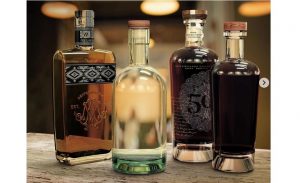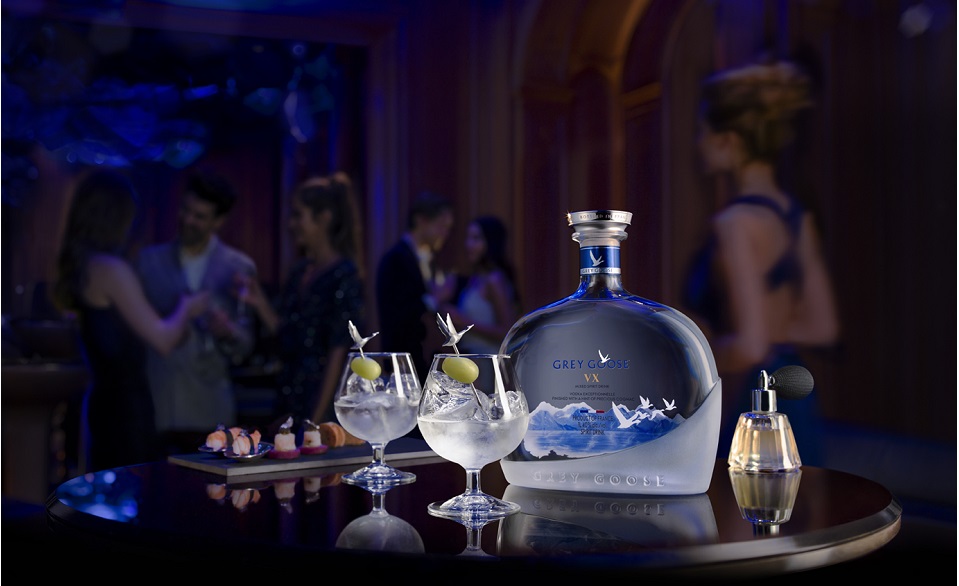Vodka is pure and neat. Glass is odorless and flavorless. Glass bottle is the best container for vodka, creating emotional connection through sight, touch and sound. Discover your reliable glass bottle manufacturer in China and make a custom glass bottle to make your brand iconic.
The definition of Vodka
Vodka is a clear distilled alcoholic beverage with different varieties originating in Poland, Russia, and Sweden (Polish: wódka, Russian: водка, Swedish: vodka). It is composed primarily of water and ethanol, but sometimes with traces of impurities and flavorings. Traditionally it is made by distilling the liquid from cereal grains that have been fermented, with potatoes arising as a substitute in more recent times, and some modern brands using fruits, honey, or maple sap as the base.
Since the 1890s, standard vodkas have been 40% alcohol by volume (ABV) (80 US proof). The European Union has established a minimum alcohol content of 37.5% for vodka. Vodka in the United States must have a minimum alcohol content of 40%.
Vodka is traditionally drunk “neat” ” (not mixed with water, ice, or other mixers), and it is often served freezer chilled in the vodka belt of Belarus, Estonia, Finland, Iceland, Lithuania, Latvia, Norway, Poland, Russia, Sweden, and Ukraine. It is also used in cocktails and mixed drinks, such as the vodka martini, Cosmopolitan, vodka tonic, screwdriver, greyhound, Black or White Russian, Moscow mule, Bloody Mary, and Caesar.
The Ingredients of Vodka
Unlike whiskey or tequila, vodka can be distilled from, well, pretty much anything. In addition to more standard potato and wheat bases, vodkas made from corn, whey and even fruit can now be found on back bars and on store shelves. And, yes, they all taste different, which means they are all worth seeking out.
Even though vodka is often referred to as a “neutral” spirit, its base ingredient still impacts its flavor and texture. For instance, corn produces a subtle sweetness, while fruit-based vodkas exhibit, yes, fruity notes. Then there are ingredients like quinoa and whey, whose characteristics are likely more difficult to imagine in your liquor, but they play important roles, nonetheless.
These are eight foods that can be turned into vodka, complete with a recommended bottle for each. There are apples, corn, honey, maple sap, potato, Quinoa, Rye and Whey.
The History of Vodka
Scholars debate the beginnings of vodka due to the little historical material available. For many centuries, beverages differed significantly compared to the vodka of today, as the spirit at that time had a different flavor, color, and smell, and was originally used as medicine. It contained little alcohol, an estimated maximum of about 14%. The still, allowing for distillation (“burning of wine”), increased purity and increased alcohol content, was invented in the 8th century.
The history of alcoholic beverages is long and interesting one. They first started appearing around 8 thousand years ago in the ancient cradles of civilization – Babylon, Armenia and Georgia. However, alcohol brewers from that period could produce their drinks solely by natural fermentation, and that process could only produce liquid with about 14% alcohol content. As the centuries and millennia went on, evolution of human civilization, technical innovations and advance in science give brewers new techniques that enabled them to create drink with much higher alcohol content. The most crucial process that enabled them to do so is distillation.
Although first historical record of distillation comes from at least 200AD Greece (their famous philosopher Alexander of Aphrodisias described how they distilled sea water into drinking water), the refinement of this process was done almost 700 years later. Around 8th -9th century, innovative Persian scientists started developing new techniques that they’ve learned from Egyptians, and managed to produce first stable distillation process in metal stills. This marked the beginning of the new age of distillation, but for the next few centuries this process was not used for the creation of more potent alcoholic drinks. Instead of that, Persian scientist used their discovery to distill countless numbers of new floral aromas which started the modern perfume industry.
While the traveling merchant slowly started to spread the news about Persian distillation across the Europe (giving it to the Catholic Church, which gave birth to the whisky in the Scotland and Ireland), Eastern European nation found one innovative way to increase alcohol content in their fermented drinks. The main way of making drink more potent is to eliminate as much water from the drink as possible, leaving it with more alcohol inside. Eastern Europeans used the harsh winters and cold temperatures to freeze fermented drinks, and because of waters high freezing point they were able to separate water ice from the remainder of alcohol. This enabled them to create more potent drinks, but the arrival of distillation gave the birth of true vodka that we know today.
Origin of modern vodka can be traced to the Poland and Russia. These two countries are in a disagreement to this day, trying to determine who was first to create this iconic drink. Historically speaking, the first record of the production of vodka (its name was derived from the Russian word “voda”, which means “water”) comes from the 9th century Russia, and the first distillery was mentioned in the Russian newspaper Vyatka Chronicle two centuries later in 1174. Polish clam of the discovery of vodka goes back to the 8th century, but many historians are in an agreement that by then they only produced crude brandy, distilled from the wine.
Popularity of vodka began to rise during 14th century. By then, vodka was used for over 2 centuries as a medical remedy, but according to legend, monk called Isidore from Chudov Monastery in Kremlin made a first recipe for Russian vodka. Using his knowledge of distillation, he created the drink that became very popular in the entire country. By 1540 Russian Tsar Ivan ‘the Terrible’decided to replenish royal treasury by introducing high taxes on vodka and establishing network of taverns across the land. These government taverns had the exclusive rights to sell vodka to the people, and the private manufacture of this drink was punishable by law (this of course was not applicable to the nobility, who still had the permission to make their own vodka). By 17th century vodka became national drink of Russia, and it became regularly served on the Royal court, used during celebration and religious ceremonies. During that time, vodka remained made with relatively low alcohol volume (not exceeding 40% by volume) and it was called by numerous names burning wine, bread wine or simply wine (Russia did not have capability to produce grapes, and very small quantities of expensive Western European wine were imported). Name vodka however referred to the medicinal type of drinks, often surpassing 75% of alcohol volume.
Between middle of 18th and 19thcentury, Russian state started heavily promoting vodka as a national drink, and its taxation became so lucrative that it represented 40% of entire annual revenue. In 1863 government monopoly on vodka production was finally repelled, giving ability to common people to produce and sell their own drinks (this eventually led to the plummeting of the drink’s prices and its slow expansion outside Russia). During the 18th century, distillation received several significant advancements, most notably process of rectification which was used to remove the unpleasant taste of drink that was caused by distillation. The most used rectification was done with charcoal, created taste of vodka that we know today (and also enabled brewers to create drinks with over 90% alcohol content in it).
Polish history of vodka was very different than in Russia. There, government did not sanction production and sale of this drink (enabled by the decree of their King Jan Olbrecht in 1564, who allowed every citizen to produce vodka), and since 16th century this drink remained the most popular drink of that nation. Even today, one of the biggest centers of vodka production is located in Polish city of Ponzan.
Spreading of the vodka outside the borders of Poland and Russia came during 1930s, when several influential vodka makers emigrated from Russia to the west. One of those immigrants Piotr Smirnov and his son Vladimir who bought the American rights of the Smirnoff vodka name (one of the biggest and influential Russian vodka brands). During very hard economic times in American Great Depression, they were forced to sell their company. In the following years Smirnoff company changed owners several times, before becoming worldwide famous after its appearance in James Bond movies. These appearances (from movies “Dr. No” and beyond) secured Smirnoff’s brand as the most popular in the world.
To this day Russia remains one of the largest consumers of vodka in the world (in 1911 vodka represented 89% of all alcohol consumed, down to 70% in 2001). Popularity of this drink was also contributed for its appearance in many cocktails (thanks to its neutral flavor), and its ability to not be detectable in the breath of the consumer. Today, vodka holds 20% of the United States market and is considered as one of the most popular alcoholic drinks worldwide.
Flint glass bottle with thick bottom is the best package for Vodka
When we go to the supermarket or on-line stores, we can find glass bottle is the most way of vodka packages.
High flint glass color, thick bottom, custom embossed logo, and custom printing will show the buyers luxury appearance. So, the premium glass bottle will help to promote your own Vodka brand.
We would like to suggest the best sale vodka glass bottle as following.
Round vodka glass bottle thick base with corks. Some people call this style as Oslo glass bottles. It is quite poplar and can be accepted in many countries like USA, the UK, European countries, and Australia.
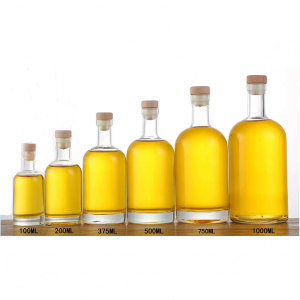
Round vodka glass bottle with long neck and corks. Some people really like thin, tall, and long neck glass bottles. We can provide premium quality glass bottle with cork. The height of 700ml glass bottle is 35.2cm, very slim style.
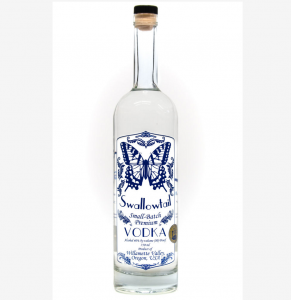
Some people call this style as Galileo glass bottle. Flat shoulder vodka glass bottles.
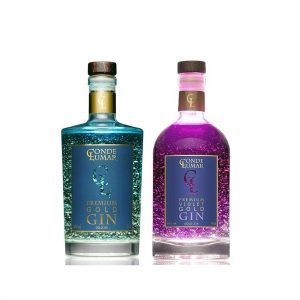
Vodka glass bottle full color printings in matt black or matt white color.
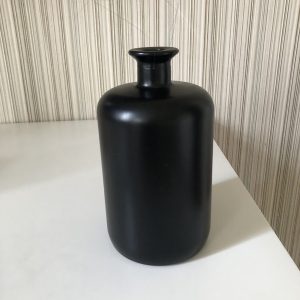
Frosted vodka glass bottles with printings. Complicated design or unique design can help people to remember the vodka brand. Please notice all the bottles above we have stock. So, we can do low MOQ like 5000pcs and fast delivery like 2 weeks if without decoration.
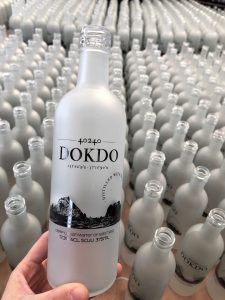
Custom mold glass vodka bottle is also an option, which will give the brand brand-new images.
